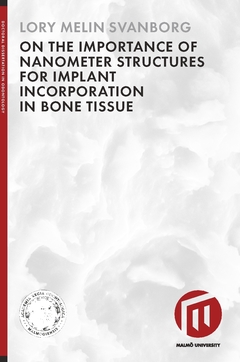Introduction
Replacing lost teeth with dental implants is today a reliable treatment
method associated with good long-term clinical results. Different
surface modifications alter the surface topography at micro- and
nanometer level of resolution as well as chemical properties, which
have shown to be of importance for osseointegration. Research
within the field of implantology is still intense and aims at further
improving the implant properties to achieve successful treatments
for patients with compromised bone as well as developing a surface
that provides faster integration to shorten the treatment period.
Furthermore, more basic science data is needed to increase our
understanding of the mechanisms involved in osseointegration.
The significance of the surface topography on the micrometer
level for implant integration is well known. However, the knowledge
of how and to what extent nanostructures may be of importance in
early bonehealing and osseointegration remains to be investigated.
Aim
The overall aim of this thesis was to describe a technique to
characterize commercial oral implants on the nanometer level when
nanostructures are applied on a microroughness and to investigate
whether or not the nanometer surface roughness was correlated to
the more well-known micrometer roughnesss; to study the real-time
initial cellular interactions of human osteoblasts and fibroblasts to
different implant surfaces with and without a coat of nanocrystalline
hydroxyapatite; and to evaluate the early bone response to a
nanocrystalline hydroxyapatite coating (nano-HA) applied on
smooth cylindrical and moderately rough screw-shaped implants. Materials and Methods
Twelve different commercial screw-shaped dental implants with
different surface modifications were examined using optical
interferometry together with Gaussian digital filters and scanning
electron microscopy (SEM). Human osteoblasts and fibroblasts
were used when investigating the initial cell-surface interaction to
different surfaces modifications with optical tweezers (OT) and
quartz crystal balance with dissipation monitoring (QCM-D). To
evaluate the effect of nanocrystalline hydroxyapatite (nano-HA)
compared to nanosized particles of titanium in early bone response,
smooth cylindrical titanium implants with no microroughness were
inserted in rabbit tibia. The implant surfaces were examined using
atomic force microscopy (AFM) and interferometry. To evaluate the
biological response, histological analyses including bone contact
(BIC) and bone area (BA), as well as qualitative analysis were
performed. Furthermore, screw-shaped sandblasted and acid etched
titanium implants coated with nano-HA of different thicknesses
and un-coated controls were evaluated in rabbit tibia as well as
femur. Interferometry, SEM and X-ray Photoelectron Spectroscopy
(XPS) were used to characterize the implant surface topography and
chemical composition. Biomechanical and histological evaluations
including BA, newly formed bone and qualitative evaluations were
performed.
Results
The studies showed that it is possible to characterize the surface
nanoroughness of commercially dental implants using interferometry.
A 1x1μm Gaussian filter was found useful to identify nanoroughness
in terms of height deviation. It was demonstrated that the implants
do have distinct roughness on the nanometer level of resolution and
that the nanoroughness is not correlated to the microroughness
when comparing mean surface roughness (Sa). Significant differences
in Sa on the nanometer scale were found among some of the
implants investigated. However, to detect specific nanostructures
an additional SEM examination is necessary. The results from
optical trap experiments showed that both osteoblasts and
fibroblasts responded in a similar way towards most of the surfaces. No difference in initial cell attachment could be detected between
the surfaces when using the QCM-D technique.
A nano-HA coating applied on smooth cylindrical implants did
not enhance bone responses in terms of bone contact (BIC) and bone
area (BA) values as compared to nano-titania.
Screw-shaped sandblasted and acid etched titanium implants
with applied nanothick (~20nm) coating of nano-HA with similar Sa
values on both micro- and nanometer scale of resolution presented
similar removal torque values, BA values and showed similar
amounts of newly formed bone as compared to un-coated controls
when placed in cortical bone. The same result was demonstrated in
trabecular bone with a submicron thick coating of nano-HA onto
sandblasted and acid etched screw-shaped implants.
Conclusions
Within the limits of the studies in this thesis, it was demonstrated
that commercially available oral implants do have nanoroughness
of various amounts and that the nanoroughness is not correlated to
the microroughness. It was demonstrated possible to observe cell attachment using
optical trapping and QCM-D, however no obvious differences
between the surfaces could be detected. A nano-HA coating applied on cylindrical titanium implants did not enhance early bone response compared to a nano-titania coating
when evaluated in cortical bone. Furthermore, sandblasted and acid
etched screw-shaped implants with applied coatings of different
thicknesses of nano-HA perform similar as un-coated controls when
evaluated in cortical and trabecular bone.


